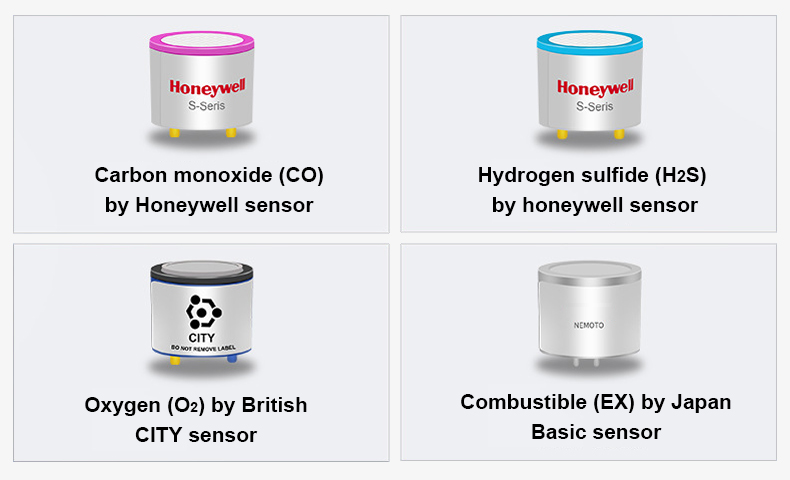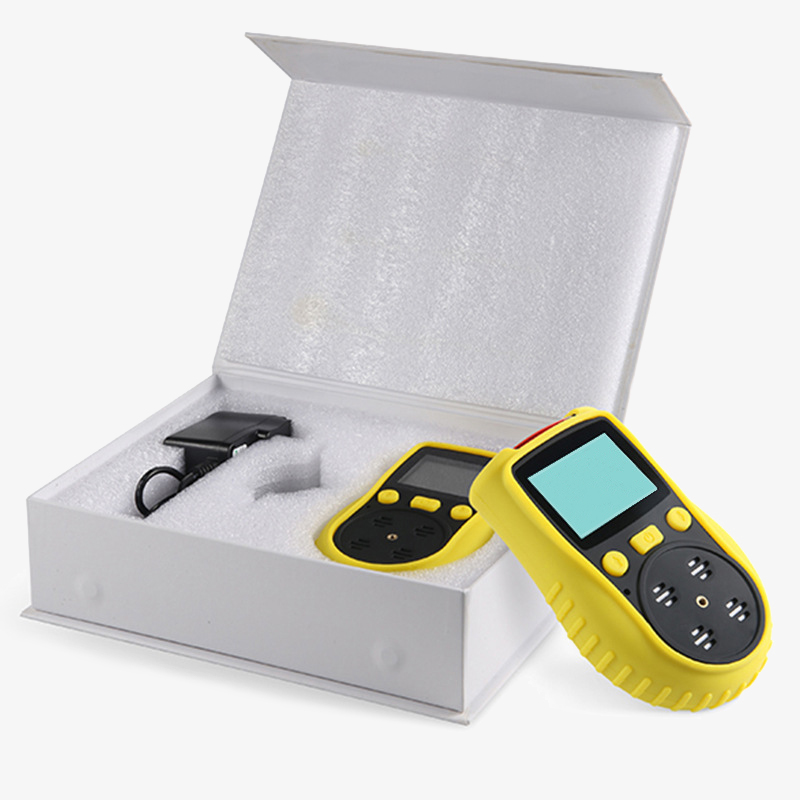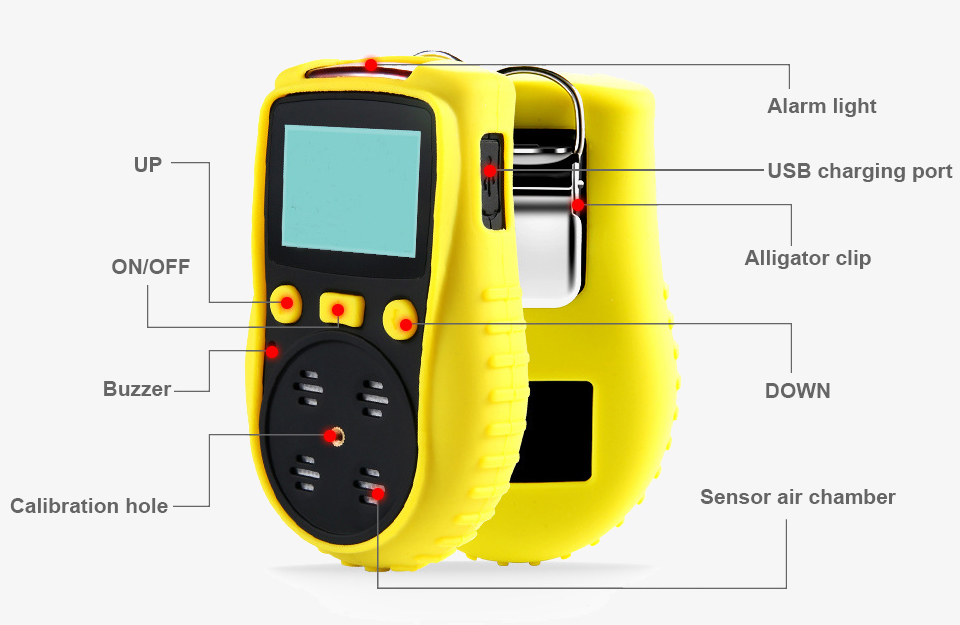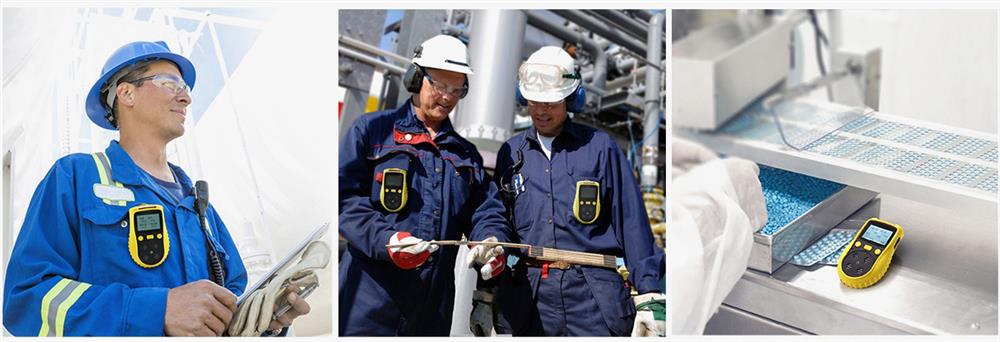sisco gas detector can measure 4 gases (CO, H2S, O2, LEL) at the same time with high accuracy and reliability, min size and high portability. Handheld multi-gas detector is widely used in oil, metallurgy, chemical, medical, agriculture, refinery and other industries.

-
Using 4 different high-precision sensors/Provides a data storage function
- The portable multi-gas detector employs the original imported high-precision sensor.
- Four random gas sensors can be combined freely.
- sisco handheld multi 4-gas detector can record 100 sets alarm data, alarm record can be checked on the device.
- Data storage function, gas detector can record 100 thousand set data, and historical data can be viewed on the device (optional function).
- Strong and upscale alligator clip, convenient to take along during operation.
- Special engineering plastics housing of high intensity, strong and durable, exquisite and comfortable in touch.

Multi gas detectors can detect any four gases (CO, H2S, O2, LEL) at the same time.
- The gas detector is available with an LCD dot matrix display and Chinese and English operation modes.
- The gas concentration unit PPM and mg/m3 can be shifted quickly.
- The battery and voltage can be checked with one press.
- One press to restore factory settings.
- Ultra-high buzzer alarm sound, alarm with sound, light and vibration at the same time.
- Rechargeable lithium polymer battery of large capacity, which ensures the gas detector works continuously for a long time.
Details

Applications
sisco portable gas detectors can be used to quickly detect CO, H2S, O2, LEL, widely used in petrochemical, fire protection, municipal construction, mines, food safety, laboratories and other industries.

| Model | GD500-4GAS |
| Sampling Method | Diffusion |
| Gas | Carbon Monoxide (CO), Hydrogen Sulfide (H2S), Oxygen (O2), Combustible (LEL) |
| Range | CO: 0 to 1000ppm, H2S: 0 to 100ppm, O2: 0 to 30%VOL, EX: 0 to 100%LEL |
| Resolution | CO: 1ppm, H2S: 0.1ppm, O2: 0.1%VOL, EX: 1%LEL |
| Accuracy | ≤±3%F.S. |
| Display | Monochrome dot matrix 128*128 LCD graphic display |
| Backlight | Backlight time is settable; the backlight will be auto-on when alarming. |
| Data Logging (Optional Function) | Storage capacity of over one hundred thousand sets. Interval time ranging from 10~3600 seconds are settable. |
| Alarms | Sound, light and vibration |
| Operation Language | Chinese/English |
| Gas Unit | Gas units ppm and mg/m3 are switchable |
| Battery | 3.7V rechargeable lithium battery with 2300mAh capacity Operating time is about 10-12h |
| Charger | Travel charger with USB. Typical charge time: 4-6 hours. |
| Explosion-proof Grade | Exia ll CT3 |
| Certification | CE, ATEX (Standard: EN IEC 60079-0:2018, EN 60079-1:2014) |
| Case Material | ABS+PC |
| Protection Grade | IP65 |
| Operating Temperature | -20℃~50℃ |
| Operating Humidity | 0~90%RH (non-condensing) |
| Dimension | 131*85*35mm |
| Weight | 240g |
Gas Detector Catalog & User Manual
 SISCO Gas Detector Catalogue
SISCO Gas Detector Catalogue SISCO GD200 Portable Gas Detector User Manual
SISCO GD200 Portable Gas Detector User Manual SISCO GD300 Online Fixed Gas Detector User Manual
SISCO GD300 Online Fixed Gas Detector User Manual SISCO GD400 Explosion Proof Portable Gas Detector User Manual
SISCO GD400 Explosion Proof Portable Gas Detector User Manual SISCO GD500 Handheld Multi Gas Detector User Manual
SISCO GD500 Handheld Multi Gas Detector User Manual SISCO GD600 Multi Gas Analyzers User Manual
SISCO GD600 Multi Gas Analyzers User Manual SISCO Gas Detector Communication Protocol V1.0
SISCO Gas Detector Communication Protocol V1.0 SISCO Single Stage Pressure Regulator User Manual
SISCO Single Stage Pressure Regulator User Manual SISCO Gas Detector Data Downloading Operation Instruction
SISCO Gas Detector Data Downloading Operation Instruction
Gas Detector Software
Q1: What is a gas detector?
A1: A gas detector is an instrument for gas leakage concentration detection, including a portable gas detector, handheld gas detector, fixed gas detector, online gas detector, etc.
Q2: What does a gas detector detect?
A2: Combustible gases: Natural gas (methane), liquefied gas, coal gas (hydrogen), acetylene, pentane, alkynes, acetone, toluene, alcohols, hydrocarbons, light oil, etc.
Toxic gases: Carbon monoxide, hydrogen sulfide, ammonia, chlorine, oxygen, phosphine, sulfur dioxide, hydrogen chloride, chlorine dioxide and other toxic and harmful gases.
Q3: What is ppm of gas detector?
A3: Parts per million or "ppm" is often used as a fractional measure of concentration. For example, a methane (molecular) concentration of 2% means that 2 out of every 100 air molecules are methane. Likewise, a methane concentration of 2 ppm means that 2 out of every 1 million air molecules are methane.
Tips for using a portable multi gas detector
- Before using the gas detector, please read the product instruction manual carefully.
- It is strictly forbidden to open the cover and replace the sensor in the field.
- Installation, commissioning, setting and other operations must be carried out by professionals.
- Calibration checks should be carried out on a regular basis, and sensors that are beyond the effective service period and faulty should be replaced in time.
- It is strictly forbidden to use gas higher than the measuring range to impact the sensor.
- Prevent the gas detector from being dropped from a height or subjected to violent shocks.
- It is strictly forbidden to expose the gas detector to a high-concentration corrosive gas environment for a long time to prevent damage to the sensor.
- The gas detector cannot be used in a high temperature and high humidity environment. If the ambient humidity is high, a filter and dehumidification device must be added.
Thank you for buying industrial test and measurement equipment on SISCO.com, all products sold by SISCO and the partner cover a 12 months warranty, effective from the date of receiving the products.
What is covered?
SISCO is responsible for providing free spare parts, and free technical support to assist the customer to repair the defective products until the problem is solved.
What is not covered?
- Product purchased from anyone other than a SISCO store or a SISCO authorized reseller.
- Expendable parts.
- Routine cleaning or normal cosmetic and mechanical wear.
- Damage from misuse, abuse or neglect.
- Damage from use of parts other than SISCO approved.
- Damage from use outside the product’s usage or storage parameters.
- Damage from use of parts not sold by SISCO.
- Damage from modification or incorporation into other products.
- Damage from repair or replacement of warranted parts by a service provider other than a SISCO authorized service provider.
- Damage caused by the application environment not meeting the product usage requirements and the failure to perform preventive maintenance.

